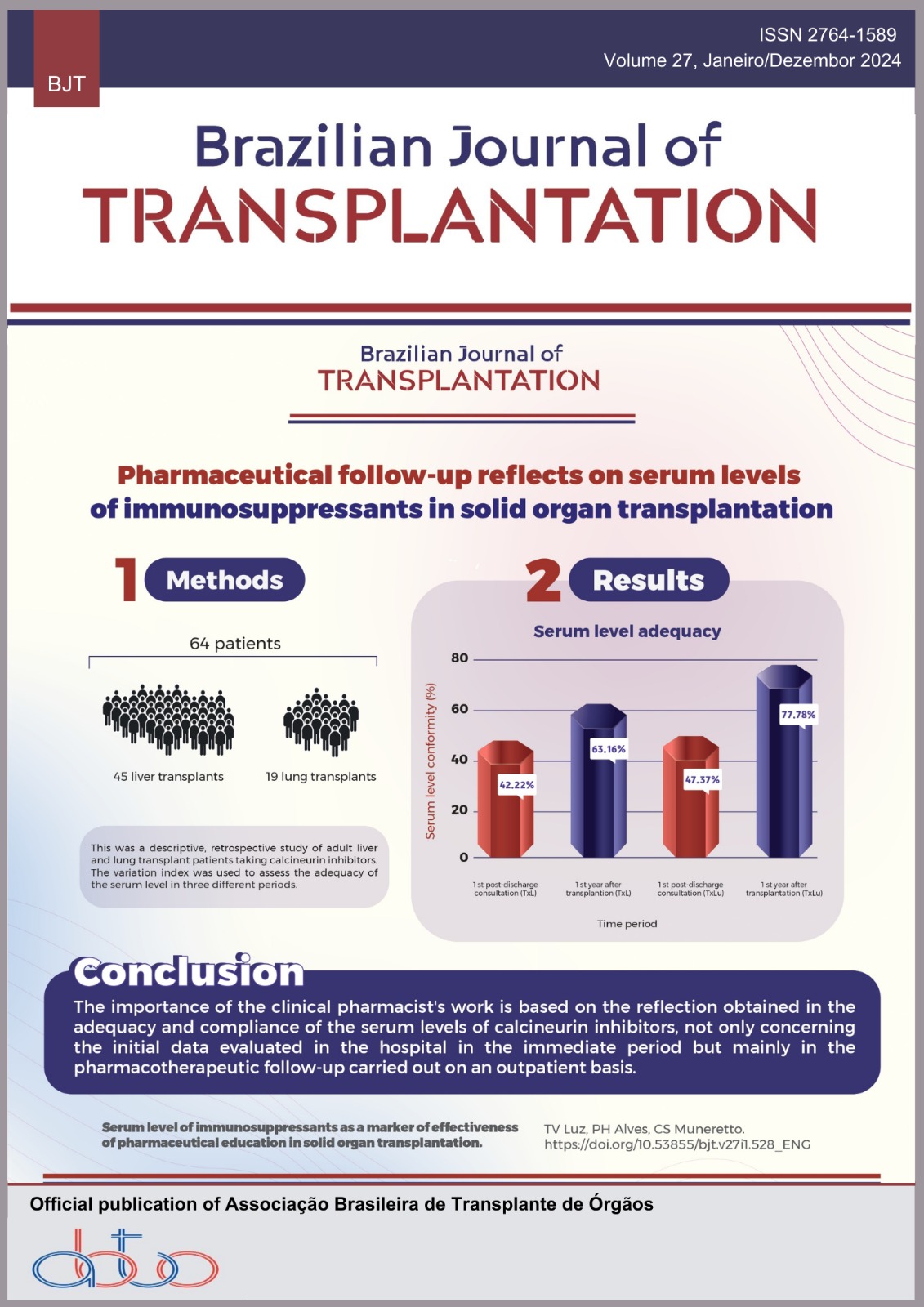Agonistas del receptor del péptido similar al glucagón-1 en receptores de trasplante renal: Un Estudio Retrospectivo de Centro Único
Palabras clave:
Glucagon-like Peptide-1 Receptor Agonists, Kidney Transplant, Diabetes MellitusResumen
Introducción: La prevalencia de diabetes post-trasplante y el aumento del riesgo cardiovascular en receptores de trasplante están en aumento. Los agonistas del receptor del péptido similar al glucagón pueden contrarrestar directamente la patogénesis de los medicamentos inmunosupresores para mejorar tanto la hiperglucemia como el aumento de peso, lo que hace atractivo su uso en esta población debido a las ventajas cardiovasculares y renales. Sin embargo, existe una falta de evidencia sustancial para receptores de trasplante renal diabéticos. Métodos: Este estudio retrospectivo fue diseñado para evaluar la eficacia y seguridad de los agonistas del receptor del péptido similar al glucagón en receptores de trasplante renal. El principal objetivo fue evaluar su influencia en parámetros clave, incluidos los niveles de hemoglobina A1c, índice de masa corporal, perfil lipídico, niveles de hemoglobina, función del injerto renal (tasa de filtración glomerular estimada) y relación proteína/creatinina urinaria. Resultados: 64 pacientes trasplantados renales fueron incluidos en esta investigación durante un período de observación mediano de 18 meses. La tasa de filtración glomerular estimada mediana al inicio fue de 61,9 mL/min/1,73m2 y se mantuvo estable durante el seguimiento. La mediana de HbA1c disminuyó de 7,5 a 7,0% (IC 95%; p<0,002). También se observó una mejora significativa en el IMC y el perfil lipídico. La hemoglobina mediana mejoró modestamente al final del seguimiento (p=0,12) y la relación proteína/creatinina urinaria disminuyó ligeramente durante el seguimiento, pero no de manera significativa. Ningún efecto secundario justificó la interrupción del medicamento. Conclusiones: Este estudio muestra que el uso de agonistas del receptor del péptido similar al glucagón es factible y bien tolerado en receptores de trasplante renal, sin efectos secundarios significativos observados. Si los agonistas del receptor del péptido similar al glucagón pueden mejorar efectivamente la supervivencia del injerto en estos pacientes aún debe ser explorado en estudios posteriores.
Descargas
Citas
Tsai SF, Chen CH. Management of diabetes mellitus in normal renal function, renal dysfunction and renal transplant recipients, focusing on glucagon-like peptide-1 agonist: a review based upon current evidence. Int J Mol Sci 2019;20(13):3152. https://doi.org/10.3390/ijms20133152
Kukla A, Hill J, Merzkani M, Bentall A, Lorenz EC, Park WD, et al. The use of GLP1R agonists for the treatment of type 2 diabetes in kidney transplant recipients. Transplant Direct 2020;6(2):e524. https://doi.org/10.1097/TXD.0000000000000971
Hart A, Smith JM, Skeans MA, Gustafspm SK, Wilk AR, Castro S, et al. OPTN/SRTR 2017 annual data report: kidney. Am J Transplant. 2019;19 Suppl 2:19-123. https://doi.org/10.1111/ajt.15274
Liou JH, Liu YM, Chen CH. Management of diabetes mellitus with glucagonlike peptide-1 agonist liraglutide in renal transplant recipients: a retrospective study. Transplant Proc 2018;50(8):2502-5. https://doi.org/10.1016/j.transproceed.2018.03.087
Andersen A, Lund A, Knop FK, Vilsboll T. Glucagon-like peptide 1 in health and disease. Nat Rev Endocrinol 2018;14:390-403. https://doi.org/10.1038/s41574-018-0016-2
Saeedi P, Petersohn I, Salpea P, Malanda B, Karuranga S; IDF Diabetes Atlas Committee. Global and regional diabetes prevalence estimates for 2019 and projections for 2030 and 2045: results from the International Diabetes Federation Diabetes Atlas, 9th ed. Diabetes Res Clin Pract 2019;157:107843. https://doi.org/10.1016/j.diabres.2019.107843
Davidson J, Wilkinson A, Dantal J, Dotta F, Haller H; International Expert Panel. New-onset diabetes after transplantation: 2003 International Consensus Guidelines. Transplantation 2003;75(10):SS3-24. https://doi.org/10.1097/01.TP.0000069952.49242.3E
Aziz F. New onset diabetes mellitus after transplant: the challenge continues. Kidney360 2021;2(8):1212-4. https://doi.org/10.34067/KID.0004042021
Pham PT, Pham PM, Pham SV, Pham PA, Pham PC. New onset diabetes after transplantation (NODAT): an overview. Diabetes Metab Syndr Obes 2011;4:175-86. https://doi.org/10.2147/DMSO.S19027
Chakkera HA, Weil EJ, Swanson CM, Dueck AC, Heilman RL, Reddy KS, et al. Pretransplant risk score for new-onset diabetes after kidney transplantation. Diabetes Care 2011;34(10):2141-5. https://doi.org/10.2337/dc11-0752
Boer GA, Holst JJ. Incretin hormones and type 2 diabetes – Mechanistic insights and therapeutic approaches. Biology (Basel) 2020;9(12):473. https://doi.org/10.3390/biology9120473
Pederson RA, Dryburgh JR, Brown JC. The effect of somatostatin on release and insulinotropic action of gastric inhibitory polypeptide. Can J Physiol Pharmacol 1975;53:1200-5. https://doi.org/10.1139/y75-168
Deacon CF, Nauck MA, Meier J, Hücking K, Holst JJ. Degradation of endogenous and exogenous gastric inhibitory polypeptide in healthy and in type 2 diabetic subjects as revealed using a new assay for the intact peptide. J Clin Endocrinol Metab 2000;85:3575-81. https://doi.org/10.1210/jcem.85.10.6855
Boer GA, Hartmann B, Holst JJ. Pharmacokinetics of exogenous GIP(1-42) in C57Bl/6 mice; extremely rapid degradation but marked variation between available assays. Peptides 2020:170457. https://doi.org/10.1016/j.peptides.2020.170457
Nauck MA, Kleine N, Ørskov C, Holst JJ, Willms B, Creutzfeldt W. Normalization of fasting hyperglycaemia by exogenous glucagon-like peptide 1 (7-36 amide) in type 2 (non-insulin-dependent) diabetic patients. Diabetologia 1993;36:741-4. https://doi.org/10.1007/BF00401145
Zander M, Madsbad S, Madsen JL, Holst JJ. Effect of 6-week course of glucagon-like peptide 1 on glycaemic control, insulin sensitivity, and beta-cell function in type 2 diabetes: a parallel-group study. Lancet 2002;359:824-30. https://doi.org/10.1016/S0140-6736(02)07952-7
Holst JJ, Ørskov C, Vagn Nielsen O, Schwartz TW. Truncated glucagon-like peptide I, an insulin-releasing hormone from the distal gut. FEBS Lett 1987;211:169-74. https://doi.org/10.1016/0014-5793(87)81430-8
Montada-Atin T, Prasad GVR. Recent advances in new-onset diabetes mellitus after kidney transplantation. World J Diabetes 2021;12(5):541-5. https://doi.org/10.4239/wjd.v12.i5.541
Mann JFE, Fonseca V, Mosenzon O, Raz I, Goldman B, Idorn T, et al. Effects of liraglutide versus placebo on cardiovascular events in patients with type 2 diabetes mellitus and chronic kidney disease. Circulation;138(25):2908-18. https://doi.org/10.1161/CIRCULATIONAHA.118.036418
Gerstein HC, Colhoun HM, Dagenais GR, Diaz R, Lakshmanan M; REWIND Investigators. Dulaglutide and cardiovascular outcomes in type 2 diabetes (REWIND): a double-blind, randomised placebo-controlled trial. Lancet 2019, 394: 121-30. Available from: https://www.thelancet.com/journals/lancet/article/PIIS0140-6736(19)31149-3/abstract
Tuttle KR, Lakshmanan MC, Rayner B, Busch RS, Zimmermann AG, Woodward DB, et al. Dulaglutide vs insulin glargine in patients with type 2 diabetes and moderate-to-severe chronic kidney disease (AWARD-7): a multicentre, open-label, randomised trial. Lancet Diabetes Endocrinol 2018;6:605-17. https://doi.org/10.1016/S2213-8587(18)30104-9
Marso SP, Bain SC, Consoli A, Eliaschewitz FG, Jódar E; SUSTAIN-6 Investigators. Semaglutide and cardiovascular outcomes in patients with type 2 diabetes. N Engl J Med 2016;375:1834-44. https://doi.org/10.1056/NEJMoa1607141
Pasternak B, Wintzell V, Eliasson B, Svensson AM, Franzén S, Gudbjörnsdottir S, Hveem K, et al. Use of glucagon-like peptide 1 receptor agonists and risk of serious renal events: Scandinavian Cohort Study. Diabetes Care 2020;43(6):1326-35. https://doi.org/10.2337/dc19-2088
Zhao X, Wang M, Wen Z, Lu Z, Cui L, Fu C, et al. GLP-1 receptor agonists: beyond their pancreatic effects. Front Endocrinol (Lausanne) 2021;23(12):721135. https://doi.org/10.3389/fendo.2021.721135
Clemens KK, Ernst J, Khan T, Reichert S, Khan Q; OK TRANSPLANT Investigators. Glucagon-like peptide 1 receptor agonists in end-staged kidney disease and kidney transplantation: a narrative review. Nutr Metab Cardiovasc Dis 2023;33(6):1111-20. https://doi.org/10.1016/j.numecd.2023.03.023
Thangavelu T, Lyden E, Shivaswamy V. A retrospective study of glucagon-like peptide 1 receptor agonists for the management of diabetes after transplantation. Diabetes Ther 2020;11:987-94. https://doi.org/10.1007/s13300-020-00786-1
Pinelli NR, Patel A, Salinitri FD. Coadministration of liraglutide with tacrolimus in kidney transplant recipients: a case series. Diabetes Care. 2013;36:e171-2. https://doi.org/10.2337/dc13-1066
Singh P, Pesavento TE, Washburn K, Walsh D, Meng S. Largest single-centre experience of dulaglutide for management of diabetes mellitus in solid organ transplant recipients. Diabetes Obes Metab 2018;21(4):1061-5. https://doi.org/10.1111/dom.13619
Halden TAS, Egeland EJ, Asberg A, Hartmann A, Midvedt K, Khiabani HZ, et al. GLP-1 restores altered insulin and glucagon secretion in posttransplantation diabetes. Diabetes Care 2016;39(4):617-24. https://doi.org/10.2337/dc15-2383
Mahmoud T, Yagan J, Hasan A, Gheith OA, Mostafa M, Rida S, et al. Sodium-glucose co-transporter 2 inhibitors & glucagonlike peptide-1 receptor agonists, efficacy & safety in diabetic kidney transplant recipients. Clin Transplant 2023;37(12):e15144. https://doi.org/10.1111/ctr.15144
Descargas
Publicado
Cómo citar
Número
Sección
Licencia
Derechos de autor 2024 Joana Freitas, José Silvano, Catarina Ribeiro, Jorge Malheiro, Sofia Pedroso, Manuela Almeida, Isabel Fonseca, La Salete Martins

Esta obra está bajo una licencia internacional Creative Commons Atribución 4.0.










